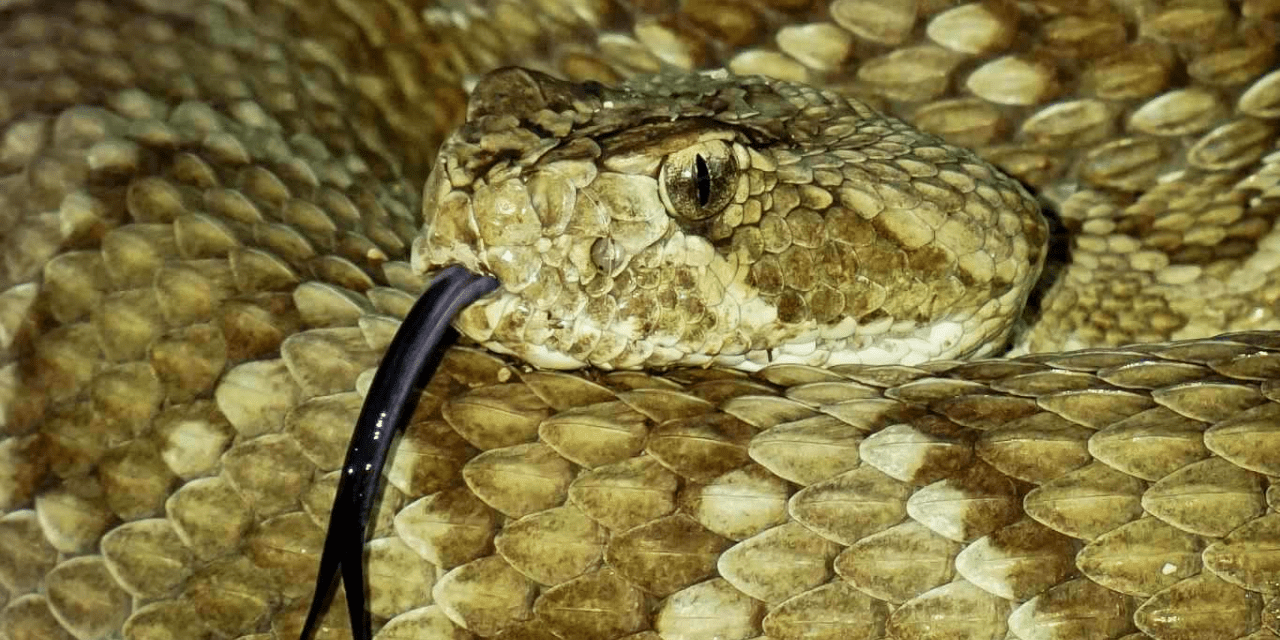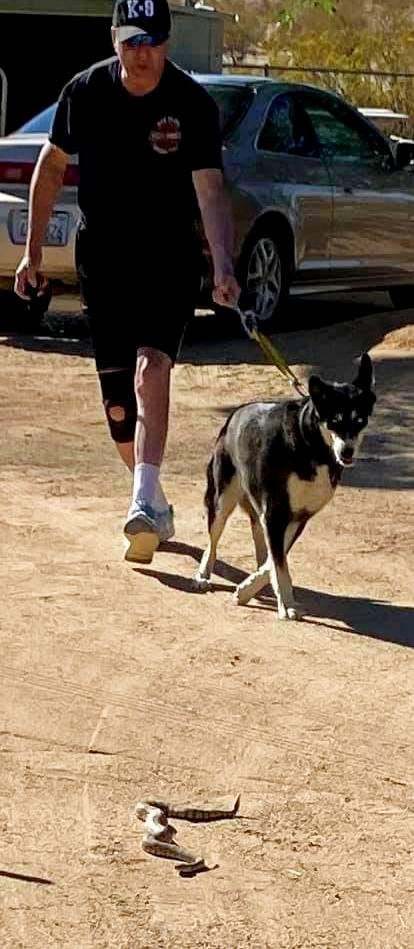
A RATTLESNAKE BIT MY DOG!
By Philip Bonafede

Philip Bonafede has been growing desert gardens for over 45 years and has been doubling as one of the greater Joshua Tree area’s snake wranglers and snake-aversion dog trainers since 1998. You can contact him at 760-401-4488 or email at pbdesert@earthlink.net
Philip Bonafede’s pet Mojave Rattlesnake, “Hollywood” Photo by Alexandra Hicks
Canine Rattlesnake bites have escalated all over the USA due to several factors: Encroachment into rattlesnake habitat (where they have lived for over 12 million years) a growing population in the Hi Desert, previous quarantines which removed humans from their habitat and a general lack of education among dogs and dog owners. Since a vast majority of our K9 pals have never seen a rattlesnake they have no idea how to react safely to avoid a fatal bite!
SUSPICIOUS BEHAVIOR
If you notice your dog exhibiting unusual behavior, after being outside, like heavy breathing, wining and acting uncomfortable then look for blood around the face area. This is a common location for a bite. The face may soon start to swell soon around the bite location. You must get your dog to the vet ASAP to avoid further complications, tissue loss or even death. Remove the collar because the swelling could strangle your dog if the neck area was bitten.
BITE SEVERITY
Just like in humans there are many variables which magnify or minimize the effects of a rattlesnake bite: Location of the bite, size and species of rattlesnake, allergies to venom or anti-venom, how much venom was injected, incompatible medications, age and size of dog.
Keep in mind that 25% of all bites are dry, meaning there is no venom, and 80% of dogs survive with treatment.Please do not kill the snake. Snakes only defend themselves when they think something is going to kill and eat them. Rattlesnakes are never ‘aggressive.’ Never ever approach, disturb, throw sticks, rocks, or try to kill a rattlesnake! This is where humans are bitten the most! Red Diamond rattlesnakes are protected under federal law.

CANINE RATTLESNAKE VACCINES
According to vets who documented cases where they treated dogs which received the vaccine and dogs which had not received the vaccine, their conclusion was they could see no difference. “There remains little fact-based data to support the efficacy of the vaccine to date,” according to Valerie Wiebe, Pharm.D with the University of California, Davis. Basically, what she’s saying, it isn’t clear if the vaccine actually works.
There is not enough research supporting the vaccine has any affect to lessen the severity of a rattlesnake bite. It has been suggested that the vaccine is only available to provide the dog owner with some assurance and peace of mind. Some believe that Benadryl helps affected canines, however, there is no science supporting that. Veterinarian friends of mine have told me that it may calm your dog a bit but that is all.
RATTLESNAKE FENCING
This is a highly effective solution to rattlesnakes on your property if installed by a professional installer. I recommend Rattlesnake Solutions out of Cave Creek Az. Bryan Hughes owner.
CANINE SNAKE AVERSION TRAINING
Rattlesnake aversion training for your dog is an intelligent choice. While a vet bill for a rattlesnake bite can exceed $3000.00, a 60-minute rattlesnake aversion class costs $150 with a free follow up! Since a rattlesnake bite causes no immediate pain, your dog will never learn from a rattlesnake bite. Aversion training provides instant, split second stimulation from a properly fitted E collar causing a microsecond muscle spasm that startles the dog. This does not hurt the dog but provides a powerful message that a rattlesnake is bad news and that close proximity is the cause of this discomfort. Most dogs carry this lesson for life.
For snake relocation or Phil’s K9 Rattlesnake Aversion Classes you can reach him via text at 760-401-4488 or email him at pbdesert@earthlink.net. Scan the QR code for his Facebook page.












